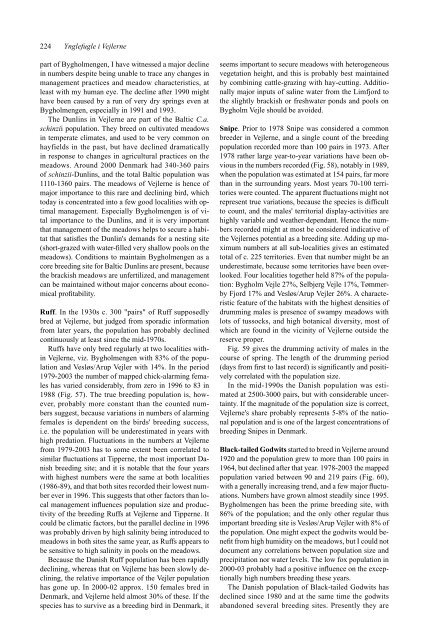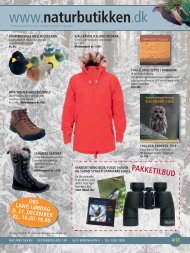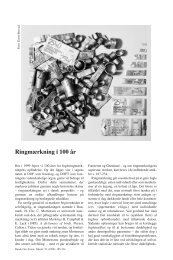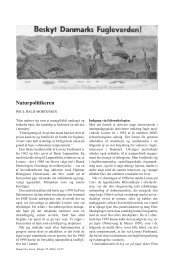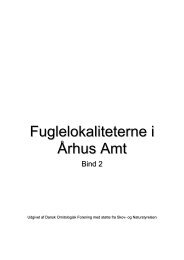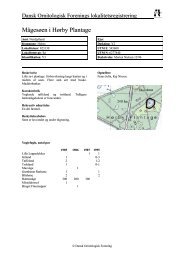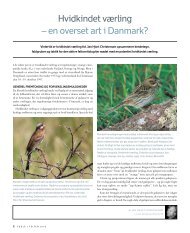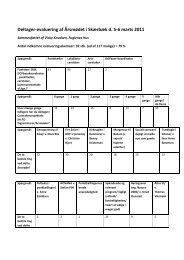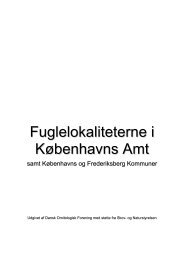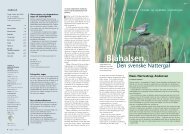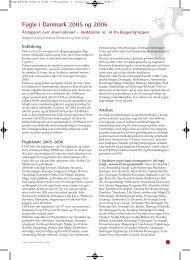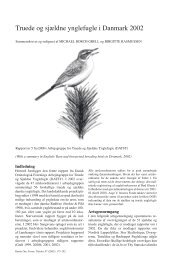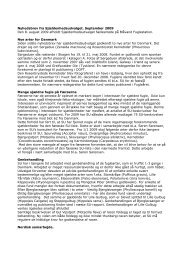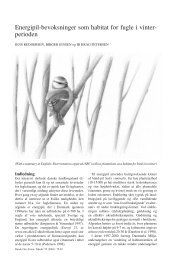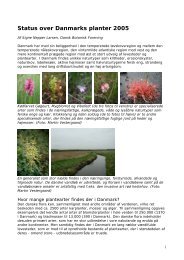Ynglefugle i Vejlerne - Dansk Ornitologisk Forening
Ynglefugle i Vejlerne - Dansk Ornitologisk Forening
Ynglefugle i Vejlerne - Dansk Ornitologisk Forening
You also want an ePaper? Increase the reach of your titles
YUMPU automatically turns print PDFs into web optimized ePapers that Google loves.
224 <strong>Ynglefugle</strong> i <strong>Vejlerne</strong><br />
part of Bygholmengen, I have witnessed a major decline<br />
in numbers despite being unable to trace any changes in<br />
management practices and meadow characteristics, at<br />
least with my human eye. The decline after 1990 might<br />
have been caused by a run of very dry springs even at<br />
Bygholmengen, especially in 1991 and 1993.<br />
The Dunlins in <strong>Vejlerne</strong> are part of the Baltic C.a.<br />
schinzii population. They breed on cultivated meadows<br />
in temperate climates, and used to be very common on<br />
hayfields in the past, but have declined dramatically<br />
in response to changes in agricultural practices on the<br />
meadows. Around 2000 Denmark had 340-360 pairs<br />
of schinzii-Dunlins, and the total Baltic population was<br />
1110-1360 pairs. The meadows of <strong>Vejlerne</strong> is hence of<br />
major importance to this rare and declining bird, which<br />
today is concentrated into a few good localities with optimal<br />
management. Especially Bygholmengen is of vital<br />
importance to the Dunlins, and it is very important<br />
that management of the meadows helps to secure a habitat<br />
that satises the Dunlin's demands for a nesting site<br />
(short-grazed with water-lled very shallow pools on the<br />
meadows). Conditions to maintain Bygholmengen as a<br />
core breeding site for Baltic Dunlins are present, because<br />
the brackish meadows are unfertilized, and management<br />
can be maintained without major concerns about economical<br />
protability.<br />
Ruff. In the 1930s c. 300 "pairs" of Ruff supposedly<br />
bred at <strong>Vejlerne</strong>, but judged from sporadic information<br />
from later years, the population has probably declined<br />
continuously at least since the mid-1970s.<br />
Ruffs have only bred regularly at two localities within<br />
<strong>Vejlerne</strong>, viz. Bygholmengen with 83% of the population<br />
and Vesløs/Arup Vejler with 14%. In the pe riod<br />
1979-2003 the number of mapped chick-alarming females<br />
has varied considerably, from zero in 1996 to 83 in<br />
1988 (Fig. 57). The true breeding population is, however,<br />
probably more constant than the counted numbers<br />
suggest, because variations in numbers of alarming<br />
females is dependent on the birds' breeding success,<br />
i.e. the population will be underestimated in years with<br />
high predation. Fluctuations in the numbers at <strong>Vejlerne</strong><br />
from 1979-2003 has to some extent been correlated to<br />
similar uctuations at Tipperne, the most important Danish<br />
breeding site; and it is notable that the four years<br />
with highest numbers were the same at both localities<br />
(1986-89), and that both sites recorded their lowest number<br />
ever in 1996. This suggests that other factors than local<br />
management inuences population size and productivity<br />
of the breeding Ruffs at <strong>Vejlerne</strong> and Tipperne. It<br />
could be climatic factors, but the parallel decline in 1996<br />
was probably driven by high salinity being introduced to<br />
meadows in both sites the same year, as Ruffs appears to<br />
be sensitive to high salinity in pools on the meadows.<br />
Because the Danish Ruff population has been rapidly<br />
declining, whereas that on <strong>Vejlerne</strong> has been slowly declining,<br />
the relative importance of the Vejler population<br />
has gone up. In 2000-02 approx. 150 females bred in<br />
Denmark, and <strong>Vejlerne</strong> held almost 30% of these. If the<br />
species has to survive as a breeding bird in Denmark, it<br />
seems important to secure meadows with heterogeneous<br />
vegetation height, and this is probably best maintained<br />
by combining cattle-grazing with hay-cutting. Additionally<br />
major inputs of saline water from the Limfjord to<br />
the slightly brackish or freshwater ponds and pools on<br />
Bygholm Vejle should be avoided.<br />
Snipe. Prior to 1978 Snipe was considered a common<br />
breeder in <strong>Vejlerne</strong>, and a single count of the breeding<br />
population recorded more than 100 pairs in 1973. After<br />
1978 rather large year-to-year variations have been obvious<br />
in the numbers recorded (Fig. 58), notably in 1989,<br />
when the population was estimated at 154 pairs, far more<br />
than in the surrounding years. Most years 70-100 territories<br />
were counted. The apparent uctuations might not<br />
represent true variations, because the species is difcult<br />
to count, and the males' territorial display-activities are<br />
highly variable and weather-dependant. Hence the numbers<br />
recorded might at most be considered indicative of<br />
the <strong>Vejlerne</strong>s potential as a breeding site. Adding up maximum<br />
numbers at all sub-localities gives an estimated<br />
total of c. 225 territories. Even that number might be an<br />
underestimate, because some territories have been overlooked.<br />
Four localities together held 87% of the population:<br />
Bygholm Vejle 27%, Selbjerg Vejle 17%, Tømmerby<br />
Fjord 17% and Vesløs/Arup Vejler 26%. A characteristic<br />
feature of the habitats with the highest densities of<br />
drumming males is presence of swampy meadows with<br />
lots of tussocks, and high botanical diversity, most of<br />
which are found in the vicinity of <strong>Vejlerne</strong> outside the<br />
reserve proper.<br />
Fig. 59 gives the drumming activity of males in the<br />
course of spring. The length of the drumming period<br />
(days from rst to last record) is signicantly and positively<br />
correlated with the population size.<br />
In the mid-1990s the Danish population was estimated<br />
at 2500-3000 pairs, but with considerable uncertainty.<br />
If the magnitude of the population size is correct,<br />
<strong>Vejlerne</strong>'s share probably represents 5-8% of the national<br />
population and is one of the largest concentrations of<br />
breeding Snipes in Denmark.<br />
Black-tailed Godwits started to breed in <strong>Vejlerne</strong> around<br />
1920 and the population grew to more than 100 pairs in<br />
1964, but declined after that year. 1978-2003 the mapped<br />
population varied between 90 and 219 pairs (Fig. 60),<br />
with a generally increasing trend, and a few major uctuations.<br />
Numbers have grown almost steadily since 1995.<br />
Bygholmengen has been the prime breeding site, with<br />
86% of the population; and the only other regular thus<br />
important breeding site is Vesløs/Arup Vejler with 8% of<br />
the population. One might expect the godwits would benet<br />
from high humidity on the meadows, but I could not<br />
document any correlations between population size and<br />
precipitation nor water levels. The low fox population in<br />
2000-03 probably had a positive inuence on the exceptionally<br />
high numbers breeding these years.<br />
The Danish population of Black-tailed Godwits has<br />
declined since 1980 and at the same time the godwits<br />
abandoned several breeding sites. Presently they are


